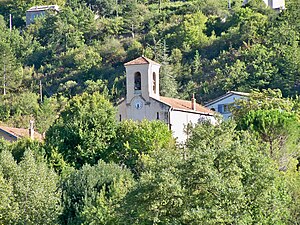Sahune
|
Sahune Sauna |
||
|---|---|---|
|
|
||
| region | Auvergne-Rhône-Alpes | |
| Department | Drôme | |
| Arrondissement | Nyons | |
| Canton | Nyons et Baronnies | |
| Community association | Baronnies en Drôme Provençale | |
| Coordinates | 44 ° 25 ' N , 5 ° 16' E | |
| height | 331-1,000 m | |
| surface | 16.55 km 2 | |
| Residents | 313 (January 1, 2017) | |
| Population density | 19 inhabitants / km 2 | |
| Post Code | 26510 | |
| INSEE code | 26288 | |
 Saint-Michel-et-Saint-George church |
||
Sahune ( Occitan : Saüna ) is a place and a community with 313 inhabitants (at January 1, 2017) in the department of Drôme in the southern French region of Auvergne Rhône-Alpes . Sahune is part of the “Regional Natural Park of the Baronnies Provençales ”.
location
The place Sahune is located on a mountain flank above the valley of the Eygues in the southwest of the Drôme department, near the border with the Vaucluse department at an altitude of about 350 to 400 m above sea level. d. M .; the next larger city, Nyons , is approx. 16 km (driving distance) to the southwest.
Population development
| year | 1800 | 1851 | 1901 | 1954 | 1999 | 2013 |
|---|---|---|---|---|---|---|
| Residents | 543 | 690 | 557 | 248 | 292 | 319 |
The population decline in the first half of the 20th century is mainly due to the remote location of the place and the loss of jobs as a result of the phylloxera crisis in viticulture and the mechanization of agriculture .
economy
The inhabitants of the place lived for centuries as a self-sufficiency from agriculture (agriculture and cattle breeding). Wine was also grown; the place still has the right to market its grapes through the Appellations Comtés Rhodaniens , Coteaux des Baronnies , Mediterranée and Drôme ; There are still a few vineyards in the vicinity of the village, but there are no longer any vintners in the village. Growing olives, apricots, cherries and apples is also important. Since the last decades of the 20th century, tourism has played an important role in the economic life of the place in the form of renting holiday apartments ( gîtes ) .
history
The old place name ( Anseduna ) is mentioned for the first time in the 11th century ; the castle ( château ) and the castle chapel date from the 13th century when Sahune belonged to the baronnies . In the 14th century, the previous landlord family died out and a certain Jean de Sahune assumed the title of baron . However, he himself also remained without descendants and so the region fell back to the French Dauphin , who gave it to the lords of Les Baux as a fief. These joined the Huguenots in the 16th century and were then ordered by Louis XIII. and Cardinal Richelieu was deposed in 1632/33 and driven from their property; Les Baux had to be razed by its own residents. In 1654, on the orders of Richelieu, Catholic troops captured Sahune and destroyed the castle and parts of the village, which was then rebuilt in the valley.
Attractions
- The old center ( Sahune-le-Vieux ) with the castle and its roof stripped chapel is restored to private initiative and repopulated part.
- The parish church of Saint-Michel-et-Saint-George , which was only completed in 1931, is located in the new district.
- outside
- The Saint-Joseph-des-Champs chapel, made entirely of quarry stones, with its simple bell gable ( clocher mur ) stands on the edge of the vineyards outside the village.
Web links
- Sahune - photos + short information (French)
- Montréal-les-Sources and Sahune - photos + short information (French)
